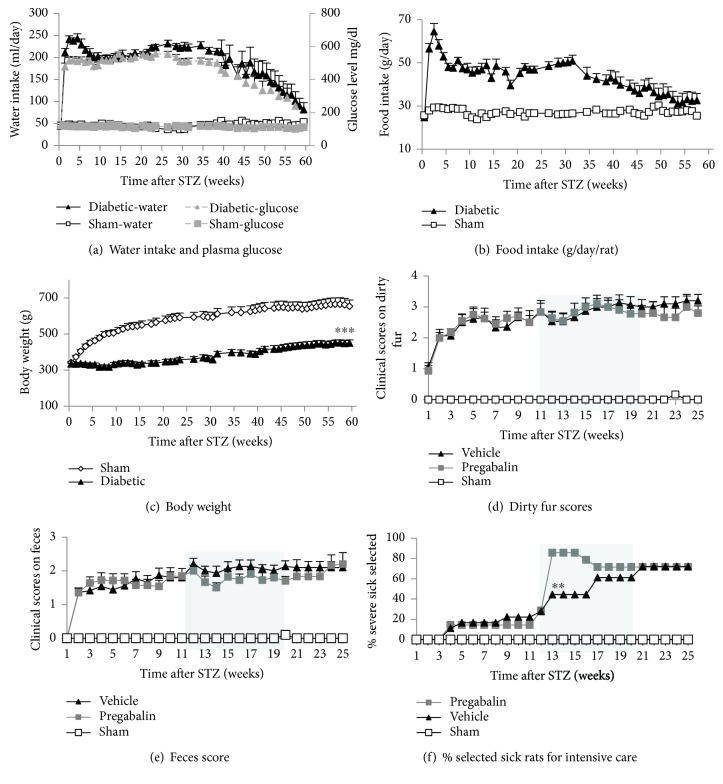Figure 1.
Long-term observation of hyperglycemia and general vital activities (body weight, food and water intake) and overall well-being (including fecal consistency, clean fur, and veterinarian selection of rats for intensive care or unscheduled sacrifice). Diabetic rats (n = 16) and age-matched sham rats (n = 10) were observed for 60 weeks after a STZ injection. An additional 16 diabetic rats and 13 sham animals were observed for up to 25 weeks post a STZ injection and then sacrificed for histological evaluation. Blood glucose levels were increased after a STZ injection. The hyperglycemia was stable for 40 weeks then normalized slowly to that of the sham animals (a). Water intake also increased sharply after a STZ injection, remained stable for 40 weeks, and then normalized to that of the sham animals by 60 weeks after the injection (a). Similarly, 24-hour food intake also increased after a STZ injection and remained relatively constant for at least 35 weeks before almost normalizing to that of sham rats by 60 weeks after a STZ injection (b). In comparison, body weight was significantly lower in STZ-injected animals as compared to sham controls, and this difference was maintained through the end of the study (c). In (d), (e), and (f), a separate group of 12 diabetic rats was treated with Pregabalin which was administrated in their drinking water ad libitum for 8 weeks from 12 to 20 weeks after a STZ injection (shadow area). Pregabalin was dosed at 30 mg/kg/day on day 1 of week 12 then at 15 mg/kg through week 18 then at 20 mg/kg/day through week 20. The diabetic rats had poorer quality haircoats and less well-formed feces than normal sham rats throughout the 25 weeks of quantitation. Treatment with Pregabalin had no effect on the diabetic rats' ability to maintain their fur clean or the consistency of their feces (d–e). The percent of rats in each group selected by a veterinarian for intensive supplemental care or unscheduled sacrifice increased with time in the STZ-injected rats (f). Pregabalin treatment further exacerbated the number of animals selected for intensive supplemental or unscheduled sacrifice (f). n = 10–32, percent, mean ± standard errors (s.e.) were calculated from each group at each time point, two-tailed (α = 2), Student's t-test, ∗∗p < 0.01 (diabetic group treated with Pregabalin compared to diabetic group treated with vehicle), ∗∗∗p < 0.001 (diabetic rats compared to normal sham rats).

